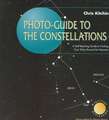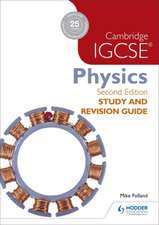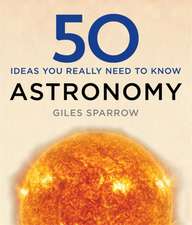Navigating the Night Sky: How to Identify the Stars and Constellations: The Patrick Moore Practical Astronomy Series
Autor Guilherme de Almeidaen Limba Engleză Paperback – 10 mai 2004
Din seria The Patrick Moore Practical Astronomy Series
-
 Preț: 258.21 lei
Preț: 258.21 lei -
 Preț: 164.94 lei
Preț: 164.94 lei -
 Preț: 324.21 lei
Preț: 324.21 lei -
 Preț: 255.10 lei
Preț: 255.10 lei - 8%
 Preț: 581.98 lei
Preț: 581.98 lei -
 Preț: 159.16 lei
Preț: 159.16 lei -
 Preț: 282.38 lei
Preț: 282.38 lei -
 Preț: 308.55 lei
Preț: 308.55 lei -
 Preț: 309.87 lei
Preț: 309.87 lei -
 Preț: 332.98 lei
Preț: 332.98 lei -
 Preț: 243.94 lei
Preț: 243.94 lei -
 Preț: 183.40 lei
Preț: 183.40 lei -
 Preț: 378.09 lei
Preț: 378.09 lei -
 Preț: 302.20 lei
Preț: 302.20 lei -
 Preț: 210.01 lei
Preț: 210.01 lei -
 Preț: 212.68 lei
Preț: 212.68 lei -
 Preț: 271.39 lei
Preț: 271.39 lei -
 Preț: 252.91 lei
Preț: 252.91 lei -
 Preț: 281.95 lei
Preț: 281.95 lei -
 Preț: 289.85 lei
Preț: 289.85 lei -
 Preț: 218.84 lei
Preț: 218.84 lei -
 Preț: 282.38 lei
Preț: 282.38 lei -
 Preț: 128.86 lei
Preț: 128.86 lei -
 Preț: 301.10 lei
Preț: 301.10 lei -
 Preț: 204.78 lei
Preț: 204.78 lei -
 Preț: 307.44 lei
Preț: 307.44 lei -
 Preț: 303.07 lei
Preț: 303.07 lei -
 Preț: 258.83 lei
Preț: 258.83 lei -
 Preț: 155.25 lei
Preț: 155.25 lei -
 Preț: 193.97 lei
Preț: 193.97 lei -
 Preț: 208.26 lei
Preț: 208.26 lei -
 Preț: 279.09 lei
Preț: 279.09 lei -
 Preț: 303.51 lei
Preț: 303.51 lei -
 Preț: 277.54 lei
Preț: 277.54 lei -
 Preț: 208.51 lei
Preț: 208.51 lei -
 Preț: 214.86 lei
Preț: 214.86 lei -
 Preț: 304.58 lei
Preț: 304.58 lei -
 Preț: 220.57 lei
Preț: 220.57 lei -
 Preț: 157.32 lei
Preț: 157.32 lei -
 Preț: 275.98 lei
Preț: 275.98 lei -
 Preț: 288.98 lei
Preț: 288.98 lei -
 Preț: 261.49 lei
Preț: 261.49 lei -
 Preț: 279.09 lei
Preț: 279.09 lei -
 Preț: 160.82 lei
Preț: 160.82 lei -
 Preț: 327.01 lei
Preț: 327.01 lei -
 Preț: 254.90 lei
Preț: 254.90 lei -
 Preț: 304.38 lei
Preț: 304.38 lei -
 Preț: 256.84 lei
Preț: 256.84 lei
Preț: 276.91 lei
Nou
Puncte Express: 415
Preț estimativ în valută:
52.99€ • 55.12$ • 43.75£
52.99€ • 55.12$ • 43.75£
Carte disponibilă
Livrare economică 24 martie-07 aprilie
Preluare comenzi: 021 569.72.76
Specificații
ISBN-13: 9781852337377
ISBN-10: 1852337370
Pagini: 220
Ilustrații: XII, 205 p.
Dimensiuni: 155 x 235 x 12 mm
Greutate: 0.39 kg
Ediția:2004
Editura: SPRINGER LONDON
Colecția Springer
Seria The Patrick Moore Practical Astronomy Series
Locul publicării:London, United Kingdom
ISBN-10: 1852337370
Pagini: 220
Ilustrații: XII, 205 p.
Dimensiuni: 155 x 235 x 12 mm
Greutate: 0.39 kg
Ediția:2004
Editura: SPRINGER LONDON
Colecția Springer
Seria The Patrick Moore Practical Astronomy Series
Locul publicării:London, United Kingdom
Public țintă
Popular/generalCuprins
1 The Constellations.- 1.1 The Viewing Location.- 1.2 Adapting the Eyes to Darkness.- 1.3 What Is the Next Step Towards Identifying Constellations and Stars?.- 1.4 Where to Start?.- 2 The Stars.- 2.1 How Far Away Are the Stars?.- 2.2 Are the Stars that Are Most Apparent in the Sky Brighter than the Others?.- 2.3 Why Do Stars Twinkle?.- 2.4 Do the Stars Move?.- 2.5 What is the Size and Mass of a Star?.- 2.6 How are Stars Formed and How Long Do they Live?.- 2.7 The Colours of the Stars.- 2.8 The Brightness of the Stars.- 2.9 Do Stars Always Have the Same Brightness?.- 2.10 “Stars” that are not Stars.- 3 The Celestial Sphere.- 3.1 So Just What Are the Constellations?.- 3.2 Measuring the Sky.- 3.3 What is the Ecliptic?.- 3.4 The Ecliptic and the Positions of the Planets in the Sky.- 3.5 The Ecliptic and the Signs of the Zodiac.- 3.6 How to Find Your Way Around the Sky.- 4 Identifying the Constellations and the Brightest Stars.- 4.1 Alignments of Stars.- 4.2 Sky Maps and Road Maps.- 4.3 Using Identification Maps.- 4.4 Ursa Major: The Best Starting Point.- 4.5 Identification Maps.- 5 The Sky Seen from the Southern Hemisphere.- 5.1 Other Viewing Locations.- 5.2 What Does the Sky Look Like in the Southern Hemisphere?.- 5.3 Stars that Cannot be Seen from Latitudes around 40° N.- 5.4 Characteristics of Constellations Close to the Celestial South Pole.- 5.5 The Southern Cross: A Good Starting Point.- 6 The Milky Way.- 7 Celestial Chart.- 8 The Sky and the Four Seasons of the Year.- 8.1 What To Do Next.- 8.2 Constellations with which the Reader Is Already Familiar.- Appendices.- 1 Examples of Ancient Representations of Some Constellations.- 2 How to Locate the Celestial North Pole in the Sky.- 3 Movement of the Sun in Line with the Constellation Ophiuchus.- 4 Bright StarsShown on the Maps and on Other Diagrams in this Book.- 5 Constellations that Are Easy or Difficult to Recognise.- 6 Useful Data Regarding the Identification and Visibility of the Constellations.- 7 Approximate Latitudes of Some Cities in the Southern Hemisphere, or Close to the Equator.- 8 Angular Distances Between Some Stars Visible between the Latitude Coordinates of 37° N and 42° N.- 9 Angular Distances Between Some Stars in the Celestial Southern Hemisphere.- 10 Symbols of the Sun, Moon and Planets.- 11 Star Names.- 12 The Greek Alphabet.
Recenzii
From the reviews:
"The author, who is a well-known Portugese amateur astronomer, methodically explains how to recognize the brighter stars and major constellations and, thus, how to find one’s way around the night sky. … This book does an effective job of doing what it sets out to do. I recommend it to anyone who wants to explore the night sky for the first time and understand how the night sky visible to us changes during the night and during the year." (Jocelyn Tomkin, The Observatory, Vol. 125 (1186), 2005)
"The book is about how to identify the stars and constellations … . This book comprises a nice selection of careful thought out diagrams which fit in beautifully with the text … . I would really recommend it to someone who is new to astronomy or as a reference book for the regular observer. … With the aid of this book … even the newest observer will be off to a flying start. … The language of the book is easily accessible … ." (Samuel George, Photopresse, Issue: 44, October, 2004)
"The book is targeted at newcomers to astronomy … . the book is interesting and accessible, the concepts discussed are easy to understand and the content flows naturally, with chapters on identifying the constellations, stars and the celestial sphere. … the book closes with 40 pages of appendices with lots of useful tables and data. The diagrams … are especially clear and concise … . This book would certainly point the newcomer in the right direction! I would recommend this practical guide … ." (Mark Allison, Popular Astronomy, July-September, 2006)
"The author, who is a well-known Portugese amateur astronomer, methodically explains how to recognize the brighter stars and major constellations and, thus, how to find one’s way around the night sky. … This book does an effective job of doing what it sets out to do. I recommend it to anyone who wants to explore the night sky for the first time and understand how the night sky visible to us changes during the night and during the year." (Jocelyn Tomkin, The Observatory, Vol. 125 (1186), 2005)
"The book is about how to identify the stars and constellations … . This book comprises a nice selection of careful thought out diagrams which fit in beautifully with the text … . I would really recommend it to someone who is new to astronomy or as a reference book for the regular observer. … With the aid of this book … even the newest observer will be off to a flying start. … The language of the book is easily accessible … ." (Samuel George, Photopresse, Issue: 44, October, 2004)
"The book is targeted at newcomers to astronomy … . the book is interesting and accessible, the concepts discussed are easy to understand and the content flows naturally, with chapters on identifying the constellations, stars and the celestial sphere. … the book closes with 40 pages of appendices with lots of useful tables and data. The diagrams … are especially clear and concise … . This book would certainly point the newcomer in the right direction! I would recommend this practical guide … ." (Mark Allison, Popular Astronomy, July-September, 2006)
Caracteristici
Provides the fundamental knowledge of the night sky required by all astronomers Does not rely on the reader owning any expensive equipment, indeed emphasises the necessity of getting to know the night sky with the naked eye Maps and Illustrations are used throughout the text The first English edition of a Portuguese bestseller includes various improvements and updates while retaining the successful structure of the original book








